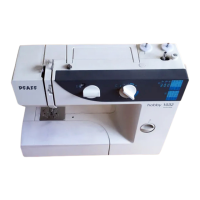Utility stitches and practical sewing
33
Buttonholes
Sewing buttonholes is very easy with all of the hobby models because the fabric does
not have to be rotated. To make sewing buttonholes even easier we recommend the
buttonhole foot.
Generally, buttonholes are sewn onto lined, doubled fabric. However, it is necessary to
additionally stabilize some materials such as silk, organza and rayon with backing pa-
per so that the fabric does not gather when being sewn.
Avalon (from Madeira) is very good for this purpose. This is a special type of stabilizer
that dissolves in water. On materials such as velvet and thick wool fabrics that feed
poorly it can be used either on or underneath the fabric. The material is thus fed more
efÀ ciently by the machine and buttonholes are much easier to sew.
Embroidery and darning threads are particularly good for sewing attractive seams.
Using a fabric marker or pin, mark the starting points of the buttonholes and always
sew a test buttonhole À rst.
Note (models 1022 and 1032):
Before every buttonhole you must slide the runner of the buttonhole foot forward
as far as it will go, i.e. the red arrow is at the first red line. The red markings are 0.5
cm apart. The red markings give you a means of determining the length of the but-
tonhole.
Tip: It is important to always sew a test buttonhole on the same fabric/stabilizer as
your project.

